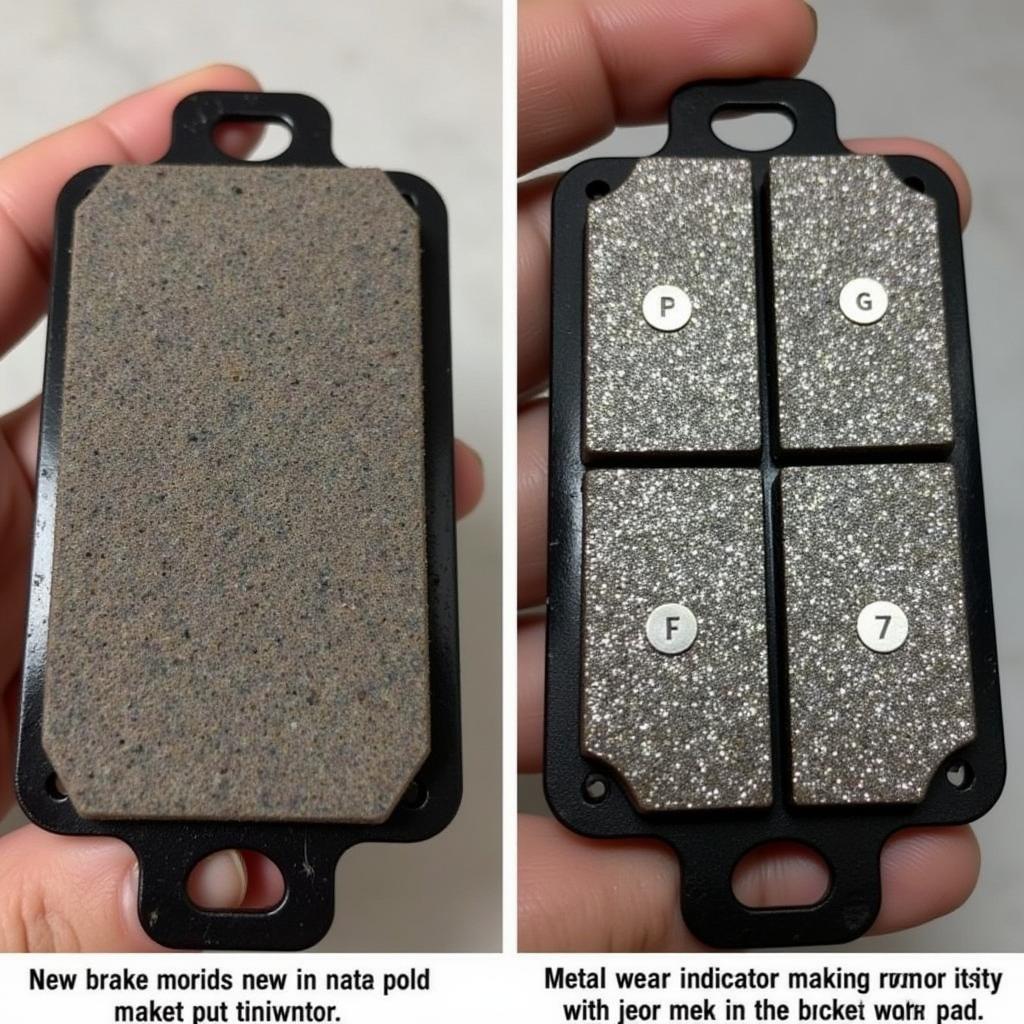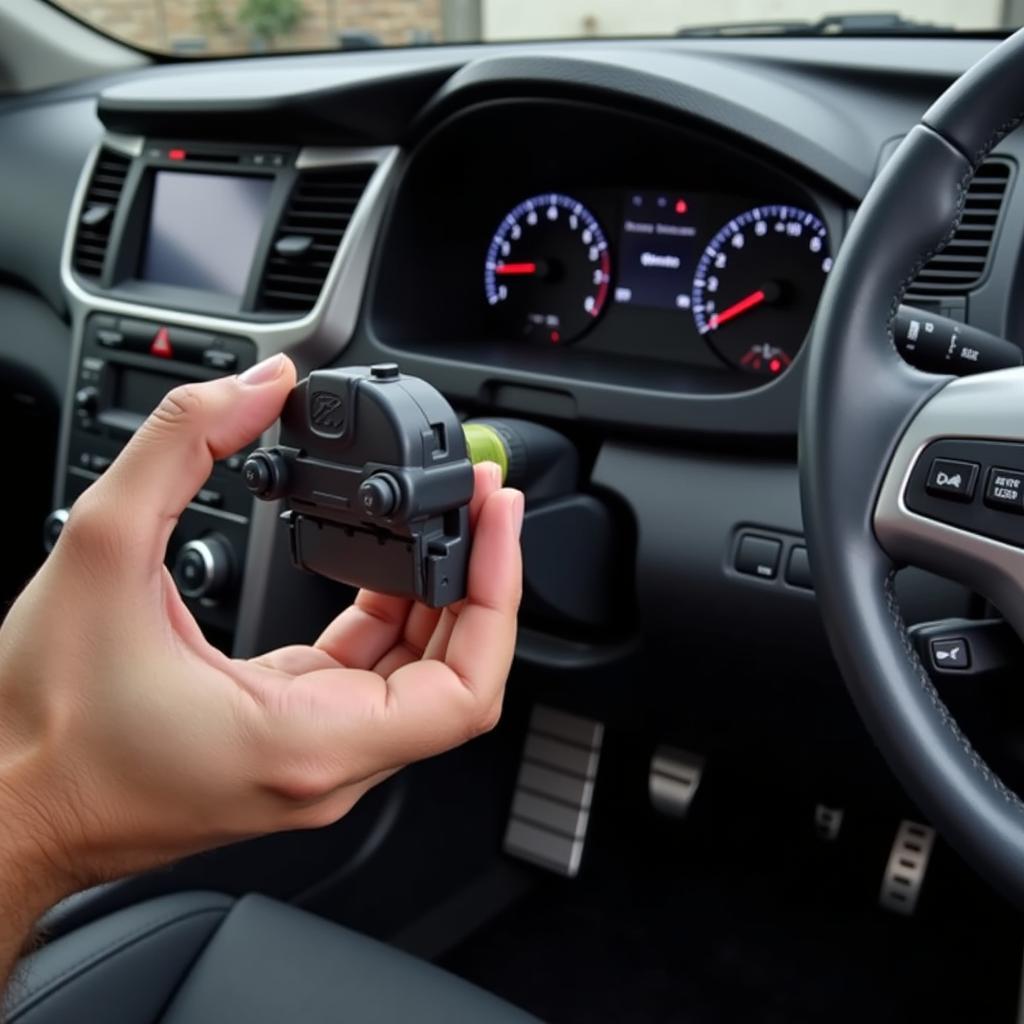A glowing brake warning light on your Hyundai Sonata’s dashboard is a nerve-wracking experience. It’s a clear signal that something isn’t right with your braking system and requires immediate attention. While it might be tempting to hope it’s a minor glitch, ignoring it could jeopardize your safety and lead to costly repairs down the line. This article will guide you through the potential causes of a brake warning light in a Hyundai Sonata and offer practical solutions to get you back on the road safely.
Understanding Your Hyundai Sonata’s Brake Warning System
Before we delve into the specifics, it’s essential to understand how your car’s brake warning system works. Your Hyundai Sonata is equipped with sensors that constantly monitor various components of your braking system. When these sensors detect an issue, the brake warning light on your dashboard illuminates, alerting you to a potential problem.
Common Reasons Your Brake Warning Light is On
Several culprits could be triggering the brake warning light on your Hyundai Sonata. Let’s explore the most frequent ones:
1. Low Brake Fluid Level
One of the most common reasons for an illuminated brake warning light is low brake fluid. Your brake fluid operates on a hydraulic system, meaning it uses fluid pressure to engage the brakes. If the fluid level drops too low, it can’t generate enough pressure, compromising your ability to stop effectively.
What to do:
- Check your brake fluid level. Locate the brake fluid reservoir under the hood of your Sonata (refer to your owner’s manual for its exact location).
- Inspect the fluid level. The reservoir has minimum and maximum markings. Ideally, the fluid level should be closer to the “Max” line.
- Add brake fluid (if necessary). If the fluid level is low, carefully add the correct type of brake fluid specified in your owner’s manual. Avoid overfilling.
- Inspect for leaks. If you notice a consistently low brake fluid level, there might be a leak in the system. It’s crucial to have a professional mechanic inspect your Sonata’s brake lines and components to identify and repair any leaks.
 Checking the Brake Fluid Reservoir on a Hyundai Sonata
Checking the Brake Fluid Reservoir on a Hyundai Sonata
2. Worn Brake Pads
Your Hyundai Sonata’s brake pads are designed to wear down over time with regular use. These pads press against the brake rotors to slow down or stop your vehicle. When the pads wear thin, a sensor embedded within them triggers the brake warning light to signal it’s time for a replacement.
What to do:
- Schedule a brake inspection. If you suspect worn brake pads, it’s best to visit a trusted mechanic specializing in Hyundai vehicles. They can assess the thickness of your brake pads and determine if they need replacement.
- Replace worn brake pads. If the inspection reveals worn brake pads, don’t delay replacing them. Driving with worn brake pads compromises your braking efficiency and can damage your rotors.
 Worn Brake Pads on a Hyundai Sonata
Worn Brake Pads on a Hyundai Sonata
3. Malfunctioning ABS System
Your Hyundai Sonata is equipped with an Anti-lock Braking System (ABS) designed to prevent wheel lockup during hard braking, enhancing vehicle control and stability. If the ABS system encounters a malfunction, it can trigger the brake warning light.
What to do:
- Don’t panic. While a malfunctioning ABS system can be concerning, it doesn’t necessarily mean complete brake failure. Your standard braking system should still function, allowing you to slow down and stop. However, you’ll be without the added safety net of ABS.
- Seek professional help. Diagnosing and repairing ABS system issues requires specialized tools and expertise. It’s crucial to take your Sonata to a qualified mechanic for proper diagnosis and repair.
Expert Insight: “Many car owners mistakenly believe a flashing ABS light is a minor issue,” says Mark Johnson, a certified automotive technician with over 20 years of experience working on Hyundai vehicles. “However, it often indicates a more serious problem within the ABS module or sensors that requires immediate attention. Ignoring it can lead to costly repairs and compromise your safety on the road.”
4. Faulty Brake Light Switch
While less common, a faulty brake light switch can also illuminate your brake warning light. This switch, located near the brake pedal, signals your brake lights to turn on when you press the brake pedal. If it malfunctions, it can disrupt the brake light circuit and trigger the warning light.
What to do:
- Check your brake lights. Ask someone to observe while you press the brake pedal to see if your brake lights illuminate. If they don’t, it could indicate a faulty brake light switch.
- Replace a defective switch. Replacing a brake light switch typically involves removing the panel under the dashboard and disconnecting and reconnecting the new switch. While it’s a relatively simple task, it’s best left to a professional if you’re uncomfortable working with electrical components.
5. Electrical Issue
In some instances, a brake warning light might illuminate due to an electrical problem, such as a blown fuse or a short circuit in the wiring harness. These issues can disrupt the signal from the brake warning system, causing the light to turn on erroneously.
What to do:
- Inspect the fuses. Consult your owner’s manual to locate the fuse box and identify the fuse associated with your brake light system. Check if the fuse is blown and replace it with a new one of the same amperage.
- Consult an auto electrician. If replacing the fuse doesn’t resolve the issue, or if you suspect a more complex electrical problem, it’s essential to seek help from a qualified auto electrician. They can diagnose and repair any electrical faults in your Sonata’s brake warning system.
 Replacing a Brake Light Switch in a Hyundai Sonata
Replacing a Brake Light Switch in a Hyundai Sonata
Don’t Ignore the Warning!
A glowing brake warning light in your Hyundai Sonata is never something to ignore. It signals a potential problem with your braking system that requires immediate attention. By understanding the common causes and following the recommended actions, you can ensure your safety on the road. However, if you’re ever unsure about diagnosing or repairing any brake-related issue, it’s always best to seek professional help from a trusted mechanic specializing in Hyundai vehicles.
FAQs about Brake Warning Lights in Hyundai Sonatas
1. Can I drive my Hyundai Sonata with the brake warning light on?
It’s not advisable to drive with a brake warning light on. It indicates a potential issue with your braking system. While you might still be able to stop, your braking performance could be compromised, putting your safety at risk.
2. How much does it cost to fix a brake warning light issue in a Hyundai Sonata?
The cost of repair varies depending on the underlying cause. It can range from a simple brake fluid top-up or brake pad replacement to more complex repairs involving the ABS system or electrical components.
3. How often should I check my Hyundai Sonata’s brake fluid?
It’s a good practice to visually inspect your brake fluid level at least once a month and top it up if necessary. Also, have your brake fluid flushed and replaced by a qualified mechanic as part of your regular maintenance schedule.
4. Can I add any type of brake fluid to my Hyundai Sonata?
No. It’s crucial to use the correct type of brake fluid specified in your owner’s manual. Using the wrong type of brake fluid can damage your brake system components and lead to costly repairs.
5. How long can I drive on worn brake pads?
There’s no definitive answer as brake pad wear depends on driving habits and conditions. However, if you hear a squealing sound when applying the brakes, it’s a strong indication that your brake pads are nearing the end of their lifespan and require immediate inspection and likely replacement.
